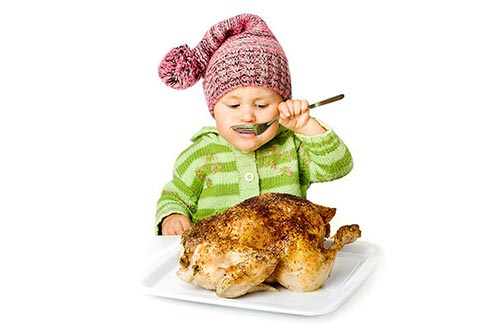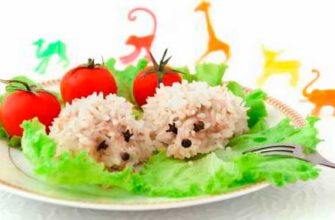Until six months, children eat only breast milk or a mixture, until this age they still do not need other products. After 6 months, the baby needs a much larger amount of nutrients than those found in breast milk or formula. From this age, the baby is gradually taught to eat cereals, vegetables, fruits. When is the time to introduce the baby to meat? What meat is given first? How to cook mashed potato crumbs? How much meat should a child eat up to one year or older at a time?
When to introduce meat to a baby?
Pediatricians advise introducing meat into the child’s menu no earlier than from 6-8 months.At the same time, meat products should not be the first complementary foods, they are introduced after vegetable, fruit puree and cereals, it is advisable to observe an interval of 2 months between the time of introduction of the first food and the time of introduction of meat. From here it becomes clear that there is a small variation in the recommended terms: at 8 months, meat is given to infants who have received their first complementary foods in half a year; at 6 months, you can introduce meat to those children who, for whatever reason, began to receive fruit or cereal complementary foods from 4 months.
Why should children not be given meat before 6 months?
- Until this age, the children's digestive system is not yet mature enough to digest such heavy foods completely.
- Meat protein negatively affects the kidneys of the child.
- Before six months, the risk of an allergy to meat protein is higher.
What is the benefit of meat for children?
- Meat is a source of protein that a child’s body needs to grow;
- Meat products contain the entire set of amino acids that are not produced by the body, but enter into it only with food;
- The meat is rich in other important trace elements - iron, phosphorus, magnesium, fluorine, cobolt and zinc. Interestingly, the iron contained in meat is absorbed better and faster than the same element from other products of plant origin;
- The meat has a fibrous dense structure, due to this, when the kids eat it, they learn to chew food.
Can meat be harmful to children?
- Some meats may cause an allergic reaction;
- The use of meat products in large quantities creates a burden on the baby's kidneys and digestive system;
- Up to 3 years, babies are not given fatty meat products, fried meat, smoked sausage and sausages.
Allergy to meat?
Pork, beef and chicken are considered allergenic foods (pork and beef are also fatty meats), so they are not suitable for the first meat feeding. It is better to begin the acquaintance of the baby with meat with rabbit meat or turkey, as they are hypoallergenic and belong to lean meats. When the baby is already used to these products, you can try to introduce chicken, tender pork and beef into the diet.
Important! If the baby has intolerance to cow's milk, refuse to introduce beef and veal into the diet. Consult with a specialist on the issue of when in your case you can try to give these types of meat to a child.
What meat does lure start with?
Rabbit meat. The easiest to digest is rabbit meat. It is not oily and does not cause allergies. It is with him that experts recommend starting lure. This product is a dietary product, since it contains virtually no fat, but it contains vitamins and minerals.
Turkey You can also offer your baby when you first meet meat products. It has very little fat and is easily digested. Turkey meat is hypoallergenic.
The best for exploring meat dishes are rabbit and turkey. Their meat is low-calorie, non-greasy, tender, very rarely causes allergies. The main disadvantage is the higher cost, and you can not buy rabbit or turkey in its natural form (but not in canned food) far from everywhere.
Other types of meat are introduced later, being careful. Let's look at why.
Chicken meat- dietary and tender. However, this is one of the most allergenic products, and in no case should you start meat complementary foods with chicken in allergic children, especially if an allergy to chicken egg protein is detected. In addition, in modern conditions, chicken for meat is grown using hormonal drugs and antibiotics that can be stored in poultry.
Pork. It is fatty meat. Even if you buy the supposedly non-fat part (scapula, back), it still contains fat. Pork may be allergic;
Beef, veal. May cause allergies in toddlers. This meat is forbidden to give to children with milk protein intolerance.
Horsemeat. Low allergenic, protein rich meat. The main disadvantage is that it is rarely found on sale.
Duck, goose and lamb are high-fat meats.The meat of waterfowl contains refractory fats, which the digestive system of the child is not able to digest. These meats are not included in the diet of children under 3 years old. Babies up to a year are not offered meat broths.
Offal begin to offer children no earlier than 10 months. The exception is babies suffering from anemia, pediatricians recommend giving them the liver even from 8-9 months. Offal contains more iron, copper and manganese. In general, the opinion about the admissibility of the inclusion of the liver in the children's menu has undergone changes in recent years: previously the liver was recommended as a good source of iron, now it is abandoned for environmental reasons (it is in the liver that the drugs and other toxic substances contained in animal feed are neutralized and accumulate).
How to make mashed meat yourself?
You can make mashed meat yourself. To do this, you need a small piece of dietary meat (approximately 20 grams). After washing it, grind the meat to make minced meat. Put it in a bowl and cook for 25 minutes. Pass the finished product through a metal sieve to achieve a homogeneous mass. Add a little mixture or breast milk to the meat and beat with a blender. Salt is not added to baby puree.
You can also boil meat cut into pieces for the child. In this case, it is recommended to bring the product to a boil, drain the water, pour the pieces of meat with clean water and cook for about 45 minutes.
Children under 8 months of age are given meat in the form of the most homogeneous puree, from 8–9 months meatballs are prepared from minced meat and knead with a fork before serving.By 10 months, if the child has teeth, meatballs and meatballs can be given without preliminary grinding, it is allowed to lightly add them and add spices (dill, parsley, bay leaf). Steam cutlets have been introduced since the year.
What kind of rabbit meat can be given to a child. How to properly prepare meat for storage in the freezer. How to cook rabbit meat directly in food:
How to introduce crumbs to meat?
- Bring the meat to a homogeneous state. To achieve this, the product is well boiled, thoroughly crushed and mixed with the mixture or breast milk;
- Before feeding the baby, make sure that the mashed potatoes are warm;
- Serving for the first acquaintance - ½ teaspoon;
- For the first time, the product is given to the child in the morning so that it is possible to observe the body's reaction throughout the day;
- In the future, meat dishes are given to children along with vegetable dishes, usually this is the third feeding of the day;
- A single serving of meat for babies is gradually increased, adding daily ½ teaspoon;
- It is not recommended to give minced meat puree after storage in the refrigerator. Children are fed only freshly prepared foods;
- When the baby gets used to the new taste, add meat to soup, cereals and vegetables;
- After 8 months, the child needs to receive a serving of meat 5 days a week. The other two days they offer fish instead;
- At the age of 10 months, start cooking meatballs so that the child learns to chew himself;
- Do not mix several types of meat until the baby gets used to each of them separately;
- Some babies refuse to eat meat. In this case, it is recommended to mix mashed meat with food that the crumbs like.
The meat is given once a day daily (after 8 months, 1-2 times a week, meat is replaced with fish). More than recommended should not be given, since an excessive load is created on the kidneys and digestive system of the child.
We also read: Introduce mashed meat into the child’s diet
What is good cooked meat puree for children?
In order not to cook the meat for the child yourself, you can buy ready-made meat puree in jars in the store. Give preference to well-known brands for which there are no complaints. Meat products for baby food from the store have their advantages.
- Mashed potatoes are prepared from the meat of animals grown in environmentally friendly conditions on environmentally friendly feed.
- All the ingredients for the preparation of baby meat puree are carefully selected, checked for compliance with quality. All the components inside the finished mashed potatoes are useful for children and correspond to age-related needs.
- Canned food is checked for hazardous impurities and, in general, its composition is carefully examined.
- Ready meat puree does not need to be cooked, but simply heated and fed to the baby.
- The meat puree in jars has a different degree of grinding, it depends on the age group of children for which the mashed potatoes are intended (the degree of grinding is marked on the package). Depending on the recommended age (determined by the marking on the packaging), canned goods differ in degree of grinding and preparation technology: homogenized - the most homogeneous, contain meat, water and rice starch; puree - more dense; finely and coarsely chopped - the meat in them is chopped, often contain salt, spices, meat broth; canned food in the form of ready meals - meatballs, meatballs.
- Producers of baby food often combine meat with other healthy products - vegetables or cereals.
- An opened can of canned meat can be stored in the refrigerator for no more than a day.
We also read: 5 questions moms about store baby puree
What is the daily norm of meat products for children up to a year and older?
Based on the age of the child, determine the amount of meat that he should receive per day.
- 6-7 months - 5-20 g.
- 8-9 months - up to 50 g.
- 10 months - 2 years - from 50 to 80 grams.
- 3 years - from 80 to 90 grams.
- 4-6 years - from 100 to 110 grams.
- 7-9 years old - from 110 to 140 grams.
- 10-13 years old - from 140 to 170 grams.
- 14-17 years old - from 200 to 220 grams.
What to look for when buying meat for children?
- When choosing beef or pork, prefer tenderloin, this part contains less fat;
- When buying rabbit meat, check the age of the animal. It is good if the rabbit is young (up to 3 months). To make mashed potatoes for the baby, use the back of the carcass, here the meat is more tender and soft;
- If you want to treat a baby turkey, take a breast. It is a tender, tasty and low-fat meat that is best absorbed. The same goes for chicken;
- Purchased meat should smell good, be uniform and resilient. If it does not smell at all or exudes an unpleasant odor, refrain from buying;
- The freshness of meat is easy to determine by color - it is unacceptable to have a gray-brown or brown shade on it. Beef should be red; pork should be pink;
- When buying meat in a store, always pay attention to the expiration date; if it is not specified or unknown, do not buy the product. Evaluate the appearance of the product. The meat should not be slippery. If you can, smell the meat and make sure it doesn't have any unpleasant odors. If the product is packed in a plastic film, make sure its integrity.
How to choose the right meat: expert advice
It is very important that the child enjoys the first meat complementary foods. Protein is necessary for the normal growth and development of the child's body. Although proteins of animal origin are also found in other products - milk, kefir, cottage cheese, fish and eggs, they cannot become a full-fledged substitute for meat. From meat products, the baby receives iron, folic acid and B vitamins, indispensable for blood and the proper development of the nervous system.
Introducing meat complementary foods | Life hack for a young mom
Meat lure for the baby
Video number 2










I started introducing meat into the baby’s diet at about 9 months old, I bought ready-made rabbit puree, my daughter honestly didn’t like it at first, she refused to eat it. I had to stop the introduction of meat for about 2 weeks, then I tried to give it again and she had already begun to eat it.
I managed to feed my child with meat only in two years, since before that he flatly refused to eat it, spit it out. He ate rabbit meat mixed with mashed potatoes at first, then he got used to others.
As a rule, I give meat complementary foods twice a day; there are enough jars for two days. We started with lean meat: beef, rabbit. While I'm afraid to give chicken and pork, I read that they are very “heavy” for the baby’s body.
I give meat from 6 months. they started with veal, from 8 months old chicken, at 9 months they ate turkey, rabbit and lean pork. at 11 months they started giving mutton without fat, milk sausages, doctor's sausage, beef liver. I think that little by little everything is possible.the main thing is more vegetables (but a little potato) and drink hot tea or fruit drink.